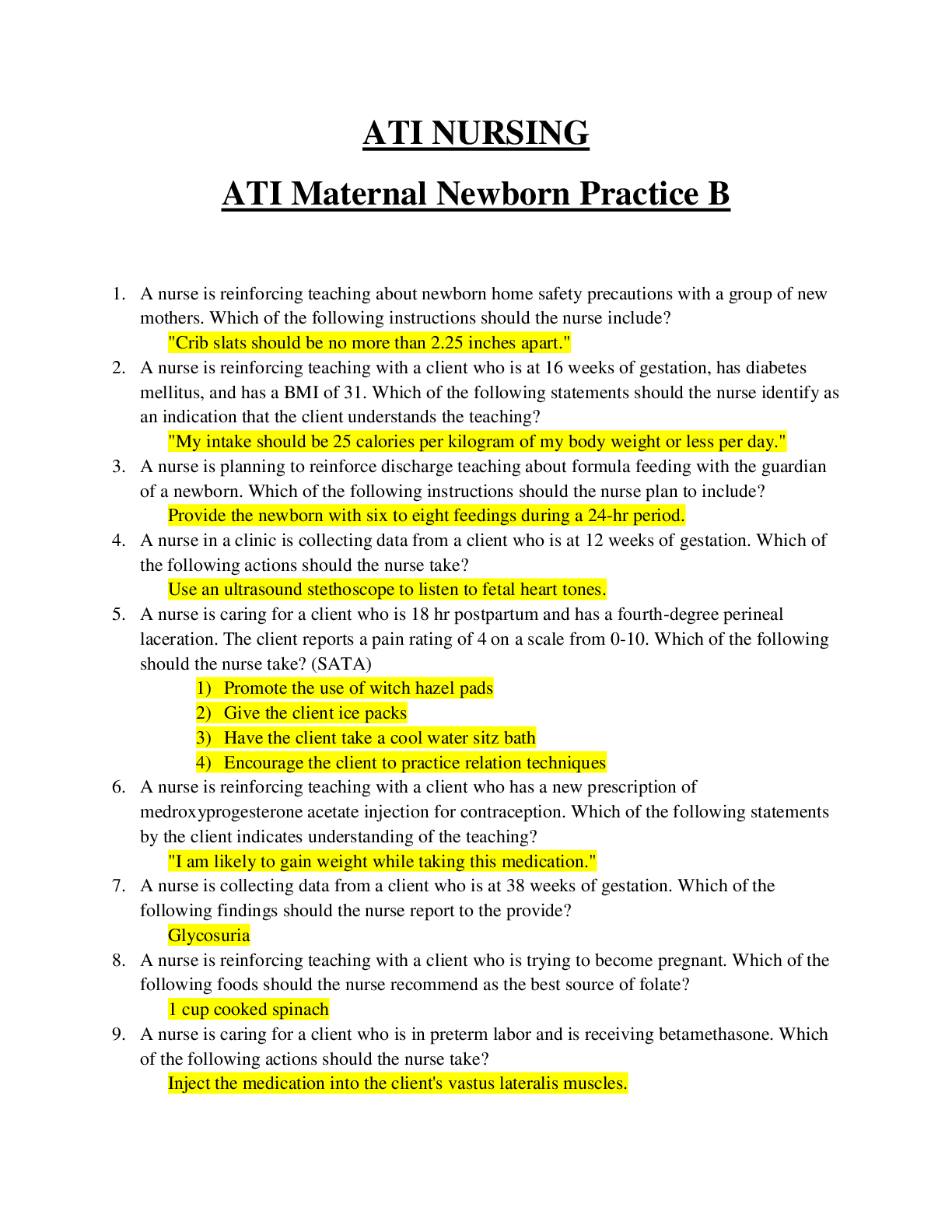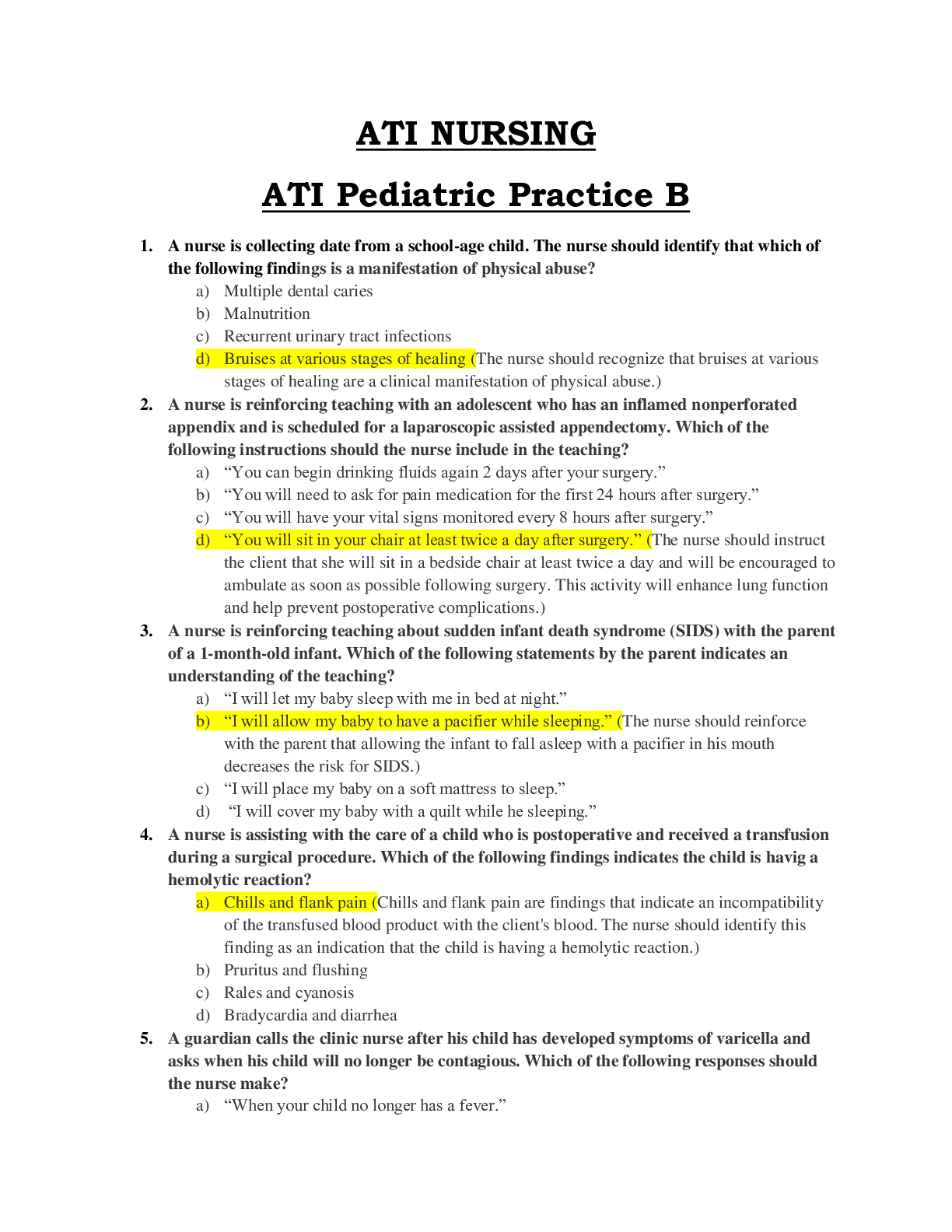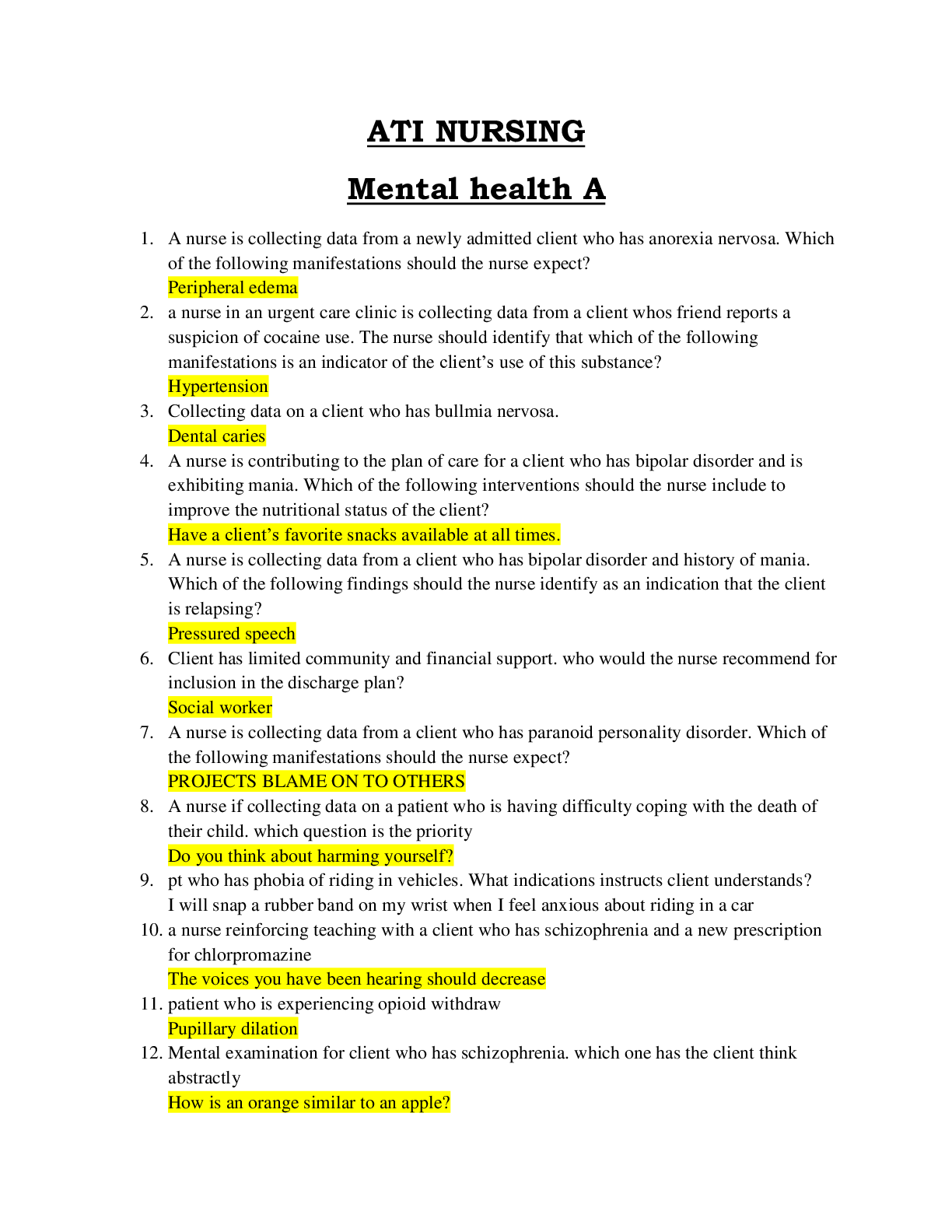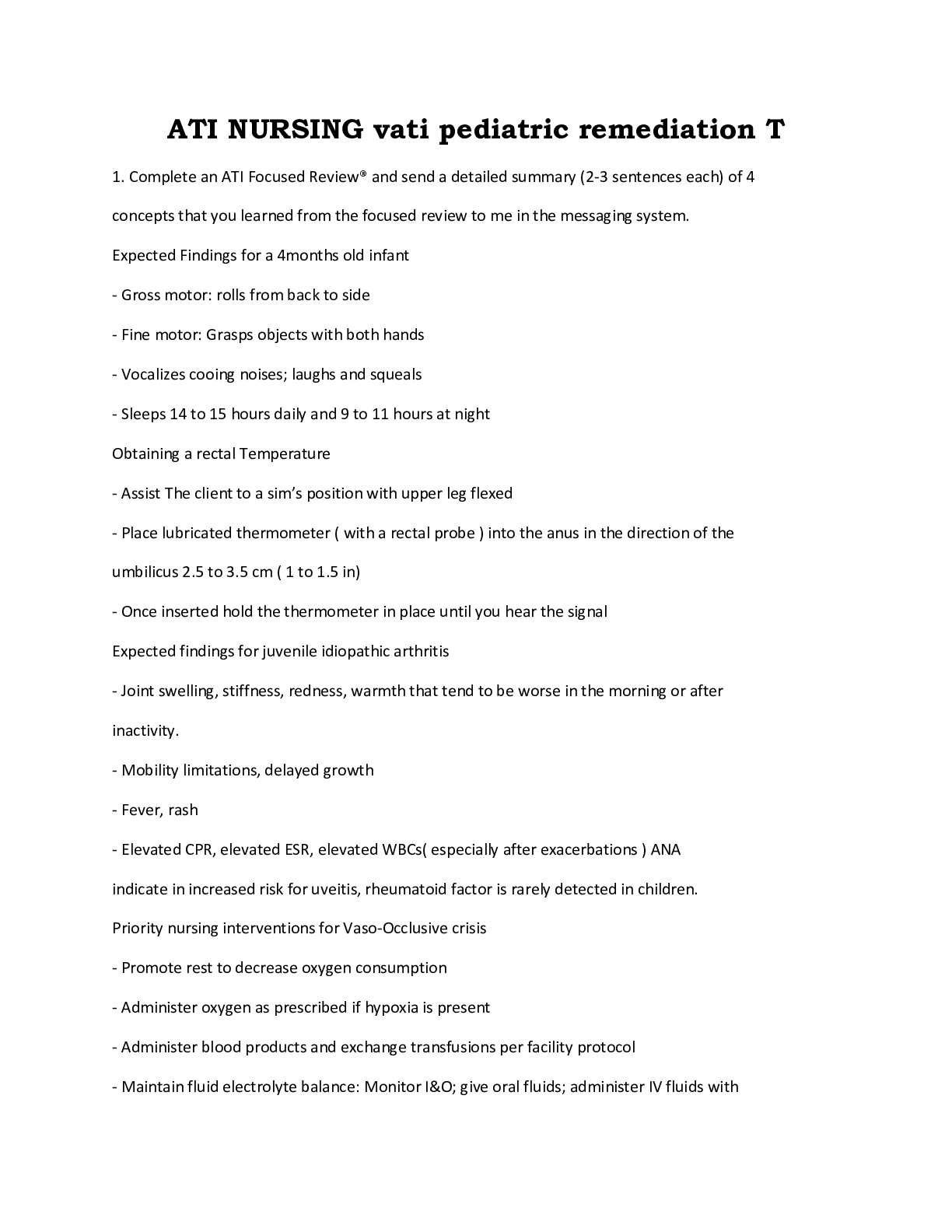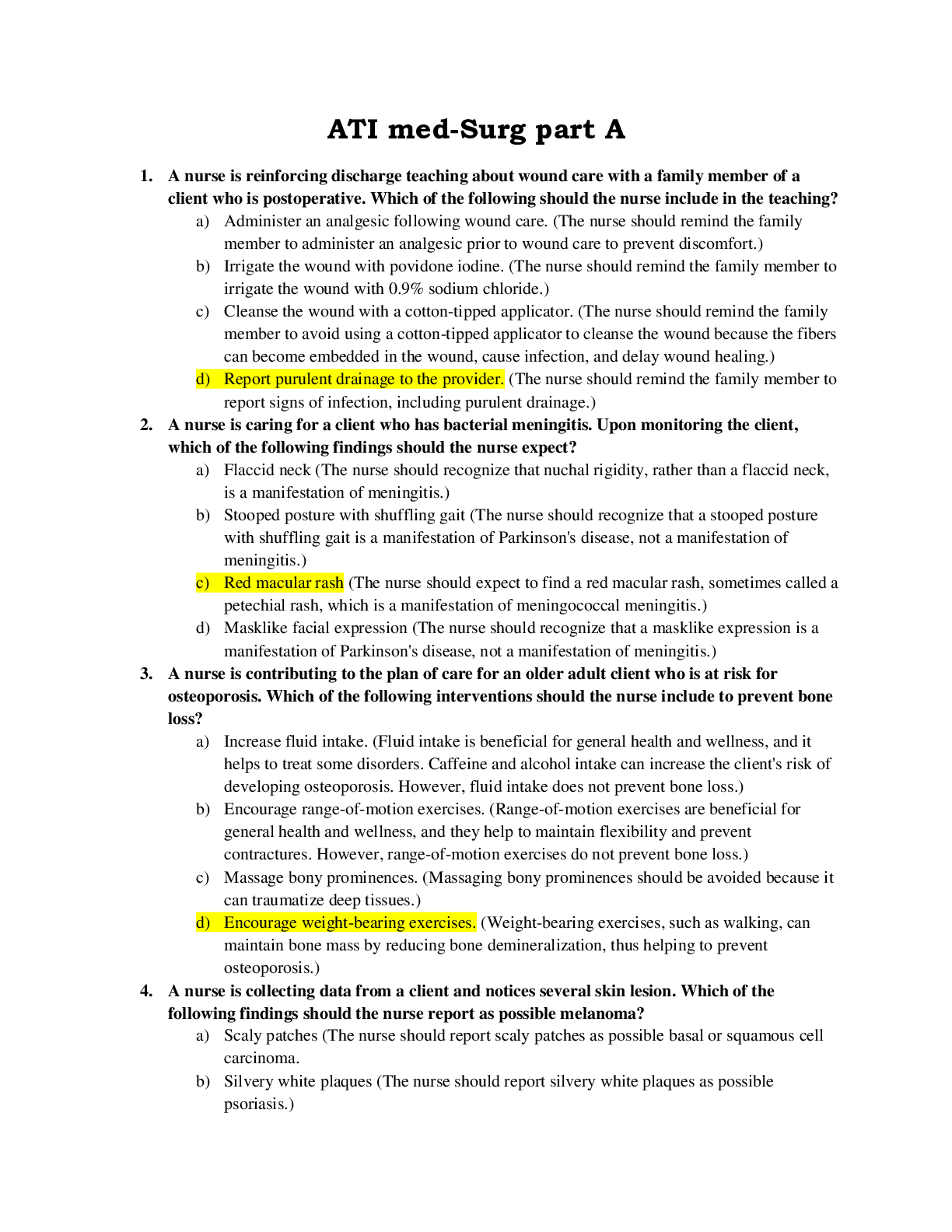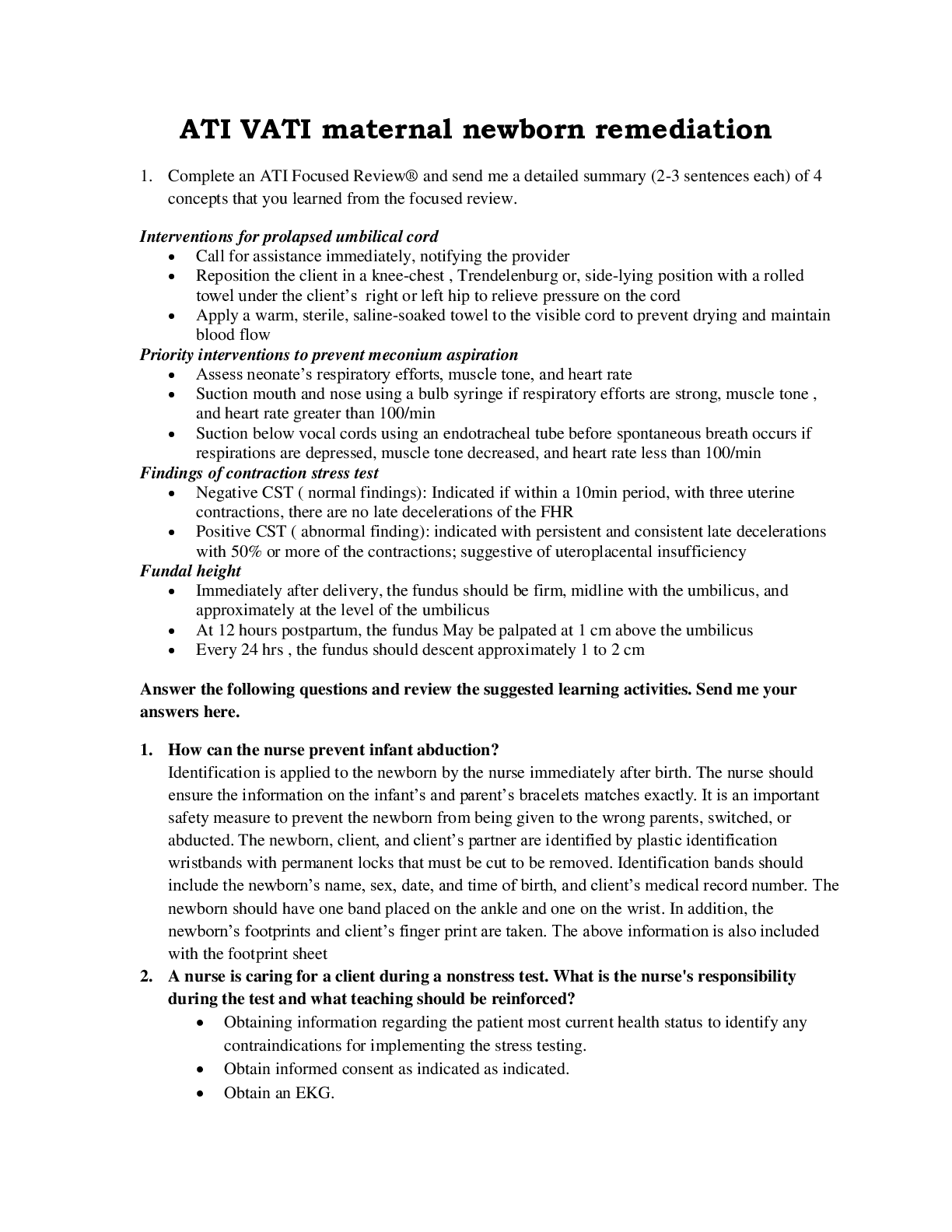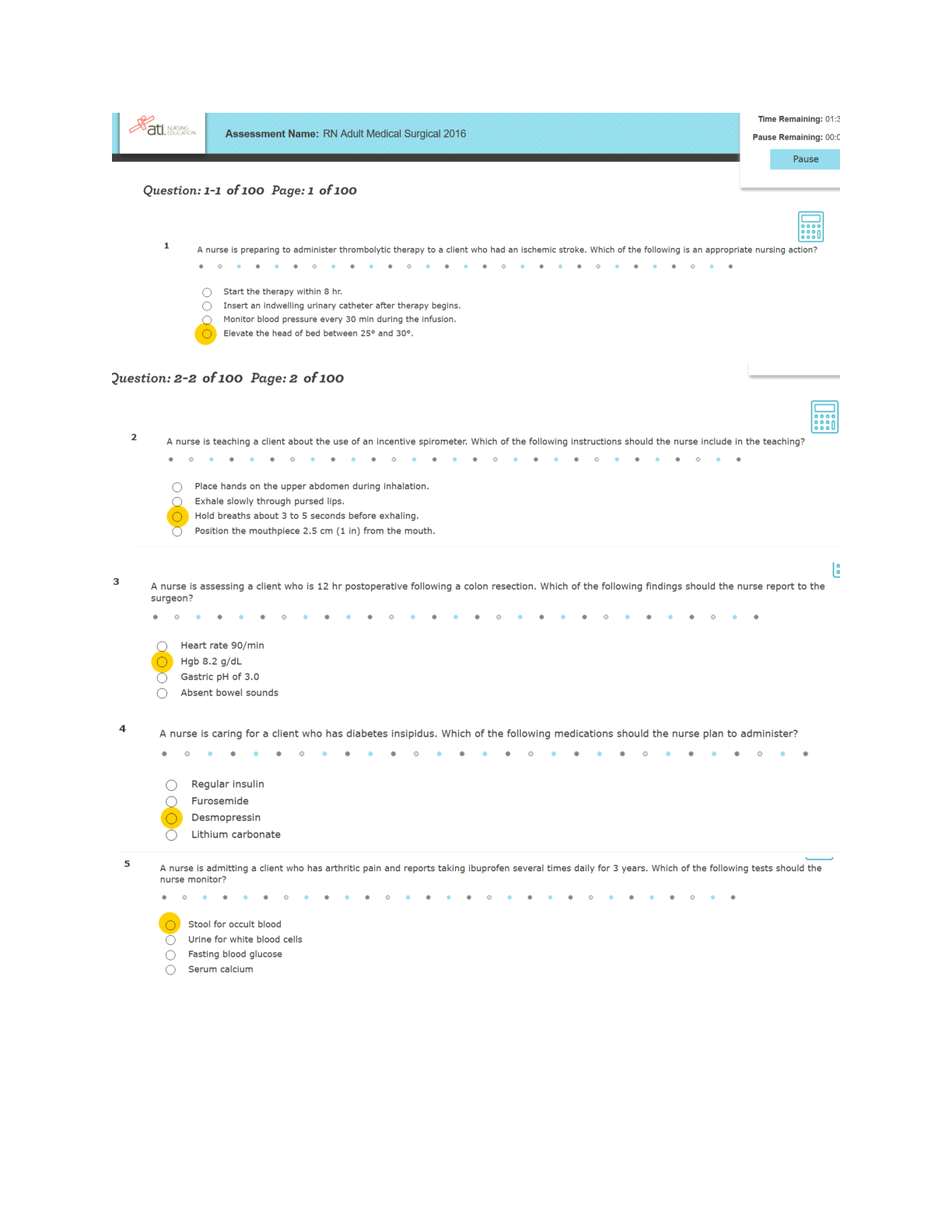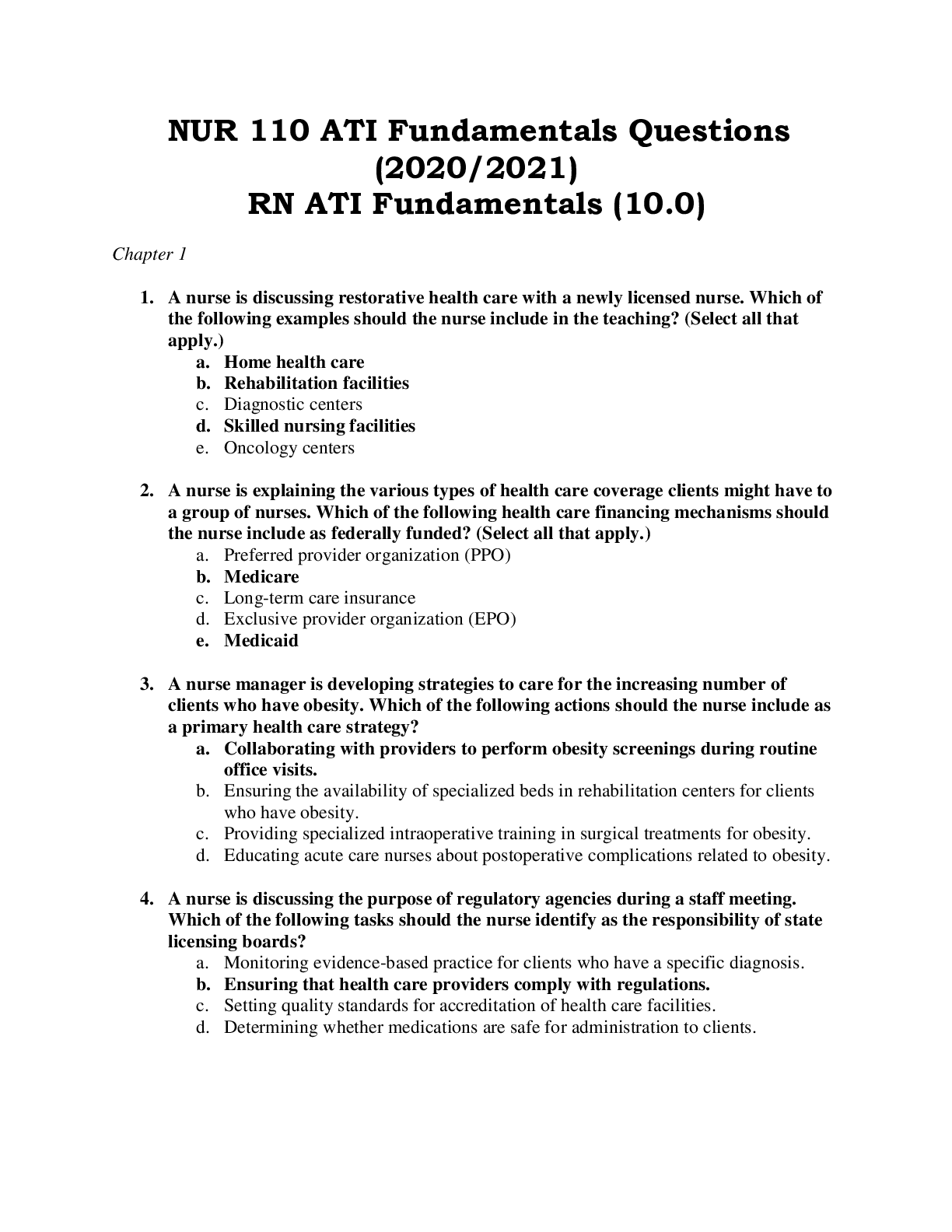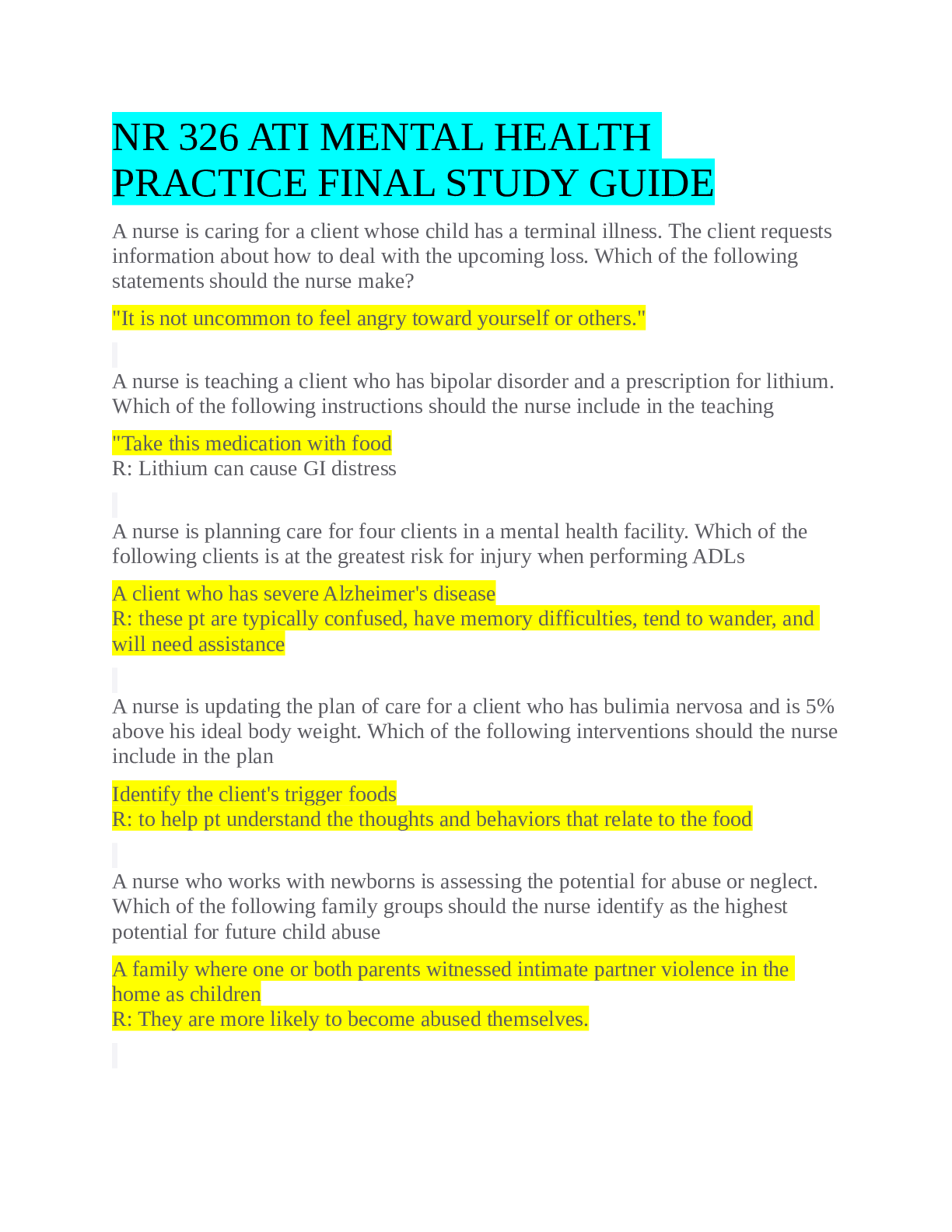*NURSING > QUESTIONS and ANSWERS > ATI EXAM 2 Latest Completed for 2022/2023 (All)
ATI EXAM 2 Latest Completed for 2022/2023
Document Content and Description Below
ATI EXAM 2 Norm pregnancy ranges hct = preg 32-42% Hgb = 10-14 g/dl Platelets 150-350k increase 3-5days post WBC 5-15,00 CHAPTER 20------ATI 23 NEWBORN ASSESSMENT Expected range... s Weight---5.5-8.8lb (2500-4000g) Length---45-55cm (18-22in) Head circum---32-36.8cm(12.6-14.5in) Chest circum---30-33cm (12-13in) VITALS Respiratory rate---do first o 30-60bpm o should not have grunting or nasal flaring==resp distress Heart rate o 110-160bpm Blood pressure o 60-80 systolic and 40-50 diastolic Temperature o 36.5-37.5 C (97.7-99.5F) LAB RANGES hgb- 14-24 hct—44%-64% platelets 150-300,000 glucose 40-60 Physiologic response of newborn to birth Resp function established when umbilical cord is cut Circulatory change occur with expulsion of fetus and cutting umbilicus o 3 shunts close-ductus arteriosus, ductus venous, and foramen ovaleo murmur over right and left auricles –latency in foramen ovale Physical assessment Apgar scoring---rules out abnormalities o Completed at 1 min and 5 min o 0-3 severe distress o 4-6 mod diff o 7-10 minimal/no diff adjusting to life don’t use rectal therm. Can injure rectal mucosa initial assessment external –skin color, peeling, birthmarks, foot creases, breast tissue, nasal patency, meconium staining chest----point of maximal impulse location, ease of breathing, auscultation for hr/tones, resp for crackles, wheezes, equality of breath sounds abdomen---rounded, umbilicus has one vein two arteries AVA Neuro----muscle tone and reflex reaction(MORO), palpation for presense/size of fontanels and suture, assess for fullness or bulges Gestational age Performed within first 48 hrs Uses measurements and new ballard scale Ballard scale---assesses neuromuscular and physical maturity o Neuro maturity— Posture Square window wrist formation Popliteal angle Scarf sign---arm over chest Heel to ear o Physical maturity Skin texture Lanugo Plantar surface creases Breast tissue buds Eyes opening /ear cartilage Genitalia development AGA---appropriate for gestational age weight in 10th-90th percentile SGA---- <10th percentile LGA-- >90th percentile LBW---low birth weight <2500 g IUGR---growth rate does not meet norms Postmature---after 42 weeks gestation with evidence of placental insufficiencySigns of cold stress—check temp Moderately cyanotic Mottled trunk Active movement in extremities Physical exam Posture o Curled up position, moderate flexion, resistant to extension of extremities Skin o Pink or acrocyanotic, no jaundice o Jaundice may appear on 3rd day and disappear on own o Texture—soft, dry, smooth, crack in hands and feet may be present. Desquamation(peeling) may occur few days after with full terms o Vernix caseosa—protective thick cheasy covering o Lanugo-fine downy hair amount varies…on pinnae of ears, forehead and shoulders o Normal deviations Milia---small white baby pimples, disappear on own Mongolian spots—bluish purple spots common on shoulders, back, and butt present on dark skin babies Telangiectatic nevi—(stork bites)—flat pink/red marks that blanch easily on neck, nose, upper eyelids, middle forehead…fade in 2nd year Nevus flammeus (port wine stain)—capillary angioma purple or red does not blanch or disappear Erythema toxicum---pink newborn rash during first 3 weeks anywhere on body no treatment needed Head o 2-3cm > chest circum o hydrocephalus==head more than 4cm that chest o microcephaly ==<32cm abnormally small head o anterior fontanel==5cm and diamond shaped o posterior fontanel==smaller and triangle o fontanels should be soft and flat…can bulge with crying bulging=increased cranial pressure, infection, or hemorrhage depressed=can mean dehydration sutures ---palpable, separated and overlapping(molding) o caput succedaneum- local swelling of soft scalp tissue caused by labor pressure expected, can be palpated as soft edematous mass, crosses suture line resolves 3-4 days no treatment o cephalohematoma—collection of blood on skull bone from birth trauma or forceps. Does not cross suture line. Egg shaped, bluish discoloration resolves 2-6 wks eyes o lacrimal glands are immature minimal or no tears o subconjunctival hemorrhages can result from pressure during birth o eyeballs can have random jerky movements Ears o Low set ears can mean down syndrome or kidney disorder o Cartilage should be firm and well formed o Inspect ears for skin tags Nose o Midline, flat and brood with lack of bridge o No drainage o Nose breathers don’t open mouth to breath til after 3wks o Apnea <15seconds is normal due to adjusting to life o Nasal blockage can = flaring of nares, cyanosis , or asphyxia Mouth o Assess strength of sucking o Lip movements should be symmetrical o Saliva should be scant…excessive=tracheoesophageal fistula o Epsteins pearls-small white cysts on gums and hard palates, normal o Protruding tongue=down syndrome o Gum and tongue should be pink Neck o Short, thick with skin folds, no webbing o Absence of head control can equal=prematurity or down syndrome Chest o Barrel shaped o Respirations primarily diaphragmatic o Clavicles intact, absence of retractions Abdomen o Umbilical – odorless no intestinal structures exhibited o Round and dome shaped o Bowel sounds present 15-20 min after birth Anogenital o Anus present, patens, uncovered o Meconium passes 24-48 hrs after birth o Female genitalia-labia majora covering labia minora and clitoris, usually edematous o Vgainal blood tinged can occur in females from mothers hormones—normal o Hymenal tag should be present o Urine passed within 24 hrs…rust color from uric acid in first couple days Extremities o Assess for full range on motion with extremities flexedo Bowed legs and flat feet present due medial muscles more developed than lateral o No click in abducting hips o Gluteal folds symmetrical o No extra digits Spine o Straight flat midline easily flexed REFLEXES o Sucking/ rooting Stroking cheek, turns head to suck Disappears 3-4months can persist to 1 yr o Palmar grasp Newborn grabs examiners fingers when touching palm Lessens 3-4 months o Plantar grasp Curling toes down Birth-8months o Moro relex Allow head and trunk to fall back in semisitting position, extends and abducts arms fingers form a C Birth-6mnths o Babinski Stroke outer edge of foor—toes fan out Birth-1yr o Stepping Hold newborn upright, does stepping movements Birth-4wks Senses o Can focus on objects 8-12 inches away o Prefer dim lighting o Mouth most sensitive to touch o Taste-prefer sweet o Smell-prefer sweet smells recognize mothers smell Diagnostics Assess cord blood at birth for blood type, rh status Complications If hypothermic, use skin to skin or radiant warmer Check temp every hour until stableCHAPTER 21 CARE OF NEWBORN---ATI 24&26 Physical newborn assessments After birth done every 30min x 2, every 1hr x 2 …then every 8hr Weight check daily In first 6-8 hrs of life check for periods of reactivity o 1st period alert, exploring activity, sucking sounds rapid hr ---160-180 lasts for 30 min after birth can have rapid rr o period of relative inactivity 60-100 min after birth quiet begins to rest/sleep HR and RR decreases o 2nd period of reactivity reawakens and responsive can gag/choke on mucous 2-8hr after birth Labs genetic mandated screening--must have been fed for at least 24hrs PKU testing Serum bilirubin-before discharge Respiratory complications Bradypnea--<30/min Tachypnea--- >60/min Abnormal—expiratory grunting, crackles, wheezes Respiratory distress---nasal flaring, retractions, grunting, gasping, labored breathing Suction mouth then nasal passage for excess mucous C-sections more susceptible to fluid remaining in lungs Is bulb doesn’t work---back blows or chest thrusts can be used BULB USE o Compress before insertion to side of mouth o Avoid center o Mouth first then nostril Identification Newborn should have wrist and ankle band matching mothers record # Staff must have photo id badge Must verify with mother each time given Thermoregulation Monitor temp for hypothermia o <97.7 o cyanosis o increased RR Keeps warm by metabolizing brown fat Cold stress can increase oxygen demands and use up brown reserves (BAD) Heat loss occurs by 4 mechanisms o Conduction- loss heat by contact with cooler surface Preheat warmer, stethoscope, and scales o Convection—heat loss from body to cooler air Do procedures under warmers Cover head, swaddle in blanket o Evaporation--- heat loss by surface liquids evaporating Rub newborn dry in warm sterile blanket immediately after delivery o Radiation--- loss of heat from body to cooler solid surface that is nearby but not in contact Keep newborn away from examining tables and windows Bathing Can begin with stabilized temp (97.7F) 36.5C Sponge bath under warmer 1-2hrs after birth Wear gloves Feeding Breast-Start immediately after birth Formula-2-4hr after birth , on demand normally 3-4hrs Breast-6-8wet diapiers or 8-12x/day as demanded Sleep Sleep 16-19hr/day Supine to decrease SIDS No shared beds Need for immunizations as a measure to prevent SIDS Elimination Monitor/document output Should void once within 24hrs 6-8x/day after day 4 stool 3-4x/day after meconium pass breastfed stools=yellow and seedy 3/day--lighter and loser than formula babies avoid alcohol diaper wipes cleanse area with water or mild soap after diaper change apple antibiotic ointment, jelly or zinc oxide per hosp protocol Infection control provide individual thermometer, diapers, bathing supplies don’t mix with other newbornsFamily education encourage holding newborn Umbilical cord care cord clamp stays for 24-48hrs cleaning with water during initial bath assess for erythema, edema and drainage at each diaper change fold diaper down and away cords fall off in 10-14 days Complications Cold stress hypoxia, acidosis, hypoglycemia newborns with resp distress=higher risk hypothermia o monitor for cold stress o warm slowly over 2-4hr o correct hypoxia with oxygen Hypoglycemia frequent in first few hrs of lide risks o mother has DM o SGA or LGA o <37wks or >42wks o monitor these risky babies within first 2hrs SIGNS o jitteriness, twitching, weak slow high-pitched cry, irregular resp effort, cyanosis, lethargy, eye rolling, seizing, blood glucose <40mg/dl heel stick o breastfeed immediately or give donor milk or formula o brain damage can result if depeleted of glucose Hemorrhage improper cord care or placement of clamp o ensure clamp is tight, check for blood seepage o notify provider is bleeding continue Medications Erythromycin EYE care prophylactic Prevents eye infection through birth canal---opthalmia neonatorum Side effects-redness, swelling, drainage, blurred vision 24-48hrs Vitamin K (phytonadione) Prevents hemorrhagic disorders Not produce in GI until day 7 Admin 0.5-1mg IM within 1hr after birth HEP B immunization Informed consent needed For healthy womens babies---at birth, 1 month, and 6months old For hep b babies – 12hrs with hep b immunoglobulin, hep B 1mnth, 2mnth, 12mnth DON’T give with vit K on same thigh CHAPTER 26 ATI—nursing newborn care Discharge 48hr after vaginal 72hr after c section Education Crying occurs when o Overfeeding, hungry, overstimulated, wet, cold, tired, hot, bored, or need burping Quieting techniques o Swaddling, close skin contact, pacifier, rhythmic noises, movement(car,swing,rocking), on stomach while bouncing legs, stimulation, eye contact Sleep-wake cycle o Sleep without feeding through night by 4-5mnths o Get day/night routine-bathe before bed to soothe, last feeding at 2300 o Use dim lights at night for changing to not fully wake them Basic holding o Cradle o Upright o Football o Colic hold—face down on arm face by elbow, quiets fussy baby Bathing o 2-3x/week using mild soap-no hexachlorophene o no immersion until umbilical and circumsicion healed o groin area washed last o for males do not push back foreskin on penis to wash o apply lotion fragrance free immediately after bathing Health benefits of circumcision o Easier hygiene o Decreased risk of UTI o Decreased risk STIs and HIV o Decreased risk of penile cancer and cervical cancer for partner o Contraindications Bleeding disorders Parents declined vit k—can be more likely to bleed Newborns with hypospadias(abnormal urethra positioning) or epispadias(urethral canal terminates on dorsum of penis) Post care- Assess for bleeding every 15-30 min during 1st hr and hourly for next 4-6hr Fan fold diaper to prevent pressure on area DO NOT wash off yellow mucous film that may develop at day 2 Complications Hemorrhage-provide gentle pressure if bleeding persists notify provider Cold stress/hypoglycemia Lack of voiding Wellness checkups- examined within 72hrs 2-3days after discharge by a pediatrician 1mnth 2mtnhs 4mths 6mths 9mnth 12mnths 15mnths 18mnths 2yrs, 2.5yrs, 3yrs, 4yrs and every year after Manifestations of illness to educate parents temp >100.4 (38C) or < 97.9F (36.6C) poor feeding frequent vomiting decreased urine, or bowels, or diarrhea labored breathing jaudince cyanosis diff waking CHAPTER 10 PREGNANCY COMPLICATIONS---ATI 7&9 Chapter 7----bleeding spontaneous abortion o terminated before 20wks or wt <500g. o types-threatened, inevitable, incomplete, complete, and missed o risks chromosomal abnormatilies(50%) maternal illness---type 1 DM advanced maternal age premature cervical dilation chronic maternal infection or malnutrition trauma/injury anomalies in fetus or placenta substance use antiphospholipid syndrome o Expected findings Backache/abdominal tenderness Ruptured membranes Fever Signs/symptoms of hermorrhage –hypotension/tachycardia o Labs Hgb/hct-if lots of blood loss Clotting factors Wbc-inection Hcg-confirm pregnancy o Therapeutic procedures D&C-dilation and curettage—dilate and scrape to remove contencts for incomplete abortions D&E-dilation and evacuation—evacuate uterine contents after 16wks gestation Prostaglandins and oxytocin—induce contractions to expel products Causes of bleeding during pregnancy 1st trimester o spontaneous abortion o ectopic pregnancy-abrupt unilateral lower quadrant pain with or without vaginal bleeding 2nd trimester o gestational trophoblastic disease- uterine size increasing abnormally fast, abnormal high levels hcg, nausea/increased emesis, dark brown red vaginal bleeding. No fetus present 3rd trimester o placenta previa-painless vaginal bleeding o abruptio placentae-vaginal bleeding, sharp abdominal pain, tender rigid uterus o Vasa previa- fetal vessels implanted into membranes rather than placenta Other causes Recurrent premature dilation of the cervix-painless bleeding with cervical dilation to fetal expulsion Preterm labor-pink stained vaginal discharge Hydatidiform mole-benign proliferation growth of the placental trophoblastNursing care for bleeding Perform pregnancy test Observe color, amount of bleeding (pad count) Avoid vaginal exams Admit meds/blood products as prescribed Use lay term miscarriage nor abortion Provide emotional support and referrals Medications Analgesics Prostaglandin-vaginal suppository Oxytocin Antibiotics RhoD if rh negative Client education Notify provider of heavy bright red bleeding, temp, or foul discharge Refrain from tub baths, sex, or placing things inside vagina for 2wks Avoid pregnancy for 2mnths Ectopic pregnancy Abnormal implantation outside uterine cavity usually in fallopian tubes 2nd most frequent cause of bleeding in early pregnancy leading cause of infertility---tube rupture Risks o STIs o Tubal surgery o IUD o Assisted reproductive technologies Findings o Unilateral stabbing pain/tenderness in lower ab quadrant o Delayed light irregular menses o Scant, dark red or brown spotting 6-8wks after last menses o Referred shoulder pain due to blood in peritoneal cavity o Faintness/dizziness---bleeding in ab cavity o Signs of hemorrhage—pallor, hypotension, tachycardia Tests o Progesterone levels----if elevated rules out o hCG levels ----if elevated rules out ectopic pregnancy therapeutic procedures o transvaginal ultrasound—shows empty uterus o methotrexate-inhibits cell division—dissolves pregnancy(avoid alcohol and folic acid—to prevent toxicity) photosensitive o salpingostomy-salvages tube if not rupturedo laparoscopic salphingectomy- removal of tube if ruptured Care o Replace fluids o Education o Prepare for surgery o Obtain hCG/progesterone levels, liver/renal function, CBC and rH type Gestational trophoblastic disease- Uterine size increasing abnormally fast, abnormal high levels hcg, nausea/increased emesis, dark brown red vaginal bleeding Embryo fails to develop Molar growths develop two types o Complete mole Paternally derived genetic material No fetus, placenta, or fluid Hemorrhage in uterine cavity occurs o Partial mole Genetic material from paternal and maternal Abnormal fetal parts, amniotic sac, fetal blood with congenital anomalies Risks o Prior molar pregnancy o Early teens or >40 years old Findings o Excessive vomiting due to elevated hCG levels o Rapid uterine growth due to trophoblastic cells o Dark bleeding or bright red can be scant or profuse o Anemia from blood loss o Clinical findings of preeclampsia o Higher than expected fundal height Labs o Serum level of hCG high with decline after 10-12 wks Therapeutic procedures o Ultrasound reveals dense growth but no fetus o Suction curettage to evacuate mole o RhoD if needed o Serum hCG done weekly for 3wks then monthly for 6months-1yr to detect GTD Nursing care o Measure fundal height o Assess GI status and appetite o Admin meds and chemo meds for malignant cells containing choriocarcinoma o Advise clients to save clots for evaluationPlacenta previa Placenta abnormally implants in lowe segment of uterus or over cervical os instead of at fundus Results in bleeding at 3rd trimester Complete or total-cervical os completely covered by attachment Incomplete/parital –cervical os partially covered Marginal or low-lying—attached to lower uterine segment but does not reach os Risks o Previous placenta previa o Uterine scarring o Age >35 o Multifetal pregnancy o Smoking Findings o Painless, bright red bleeding 2nd-3rd trimester o Uterus soft, relaxed, nontender with normal tone o Fundal height greater than expected for gest. Age o Fetus in breech, oblique, or transverse position o Reassuring FHR o Decreased urinary output Labs o Hgb & hct for blood loss assessment o CBC/coagulation profile o Kleihauer-betke test—detects fetal blood in maternal circulation o Transabdominal or transvaginal ultrasound for placement of placenta Care o Assess bleeding & fundal height o Perform leopold maneuvers o Refrain from vaginal exam o Have oxygen available o Bed rest o Nothing inserted vaginally Abruptio placentae Premature separation of the placenta from the uterus After 20wks gest (3rd trim) Leasing cause maternal death Coagulation defect (DIC) is often associated with abruption Risks o Maternal HTN o Blunt traumao Cocaine use o Smoking o Previous abruption o Premature rupture of membranes o Multifetal pregnancy Findings o Sudden uterine pain with dark red bleeding o Uterine tenderness o Contractions with hypertonicity o Fetal distress o Clinical findings of hypovolemic shock Labs o Hgb and hct decreased o Clotting defects o Kleihauer betke test o Biophysical profile for fetal well being o Ultrasound for placental placement Careo Palpate uterus for tenderness and tone o Assess fhr o Immediate birth is the management Need 8-10L o2 Vasa previa Fetal umbilical vessels implant into fetal membranes rather than placenta Velamentous insertion of the cord—vessels begin in the branch at the membranes then course to the placenta Succenturaite insertion of the cord—placenta divided into 2 or more lobes and not one mass Battledore insertion of the cord—marginal insertion, increased risk fetal hemorrhage Use ultrasound for well being and vessel assessment CHAPTER 9 ATI—MEDICAL CONDITIONS Cervical insufficiency(premature cervical dilation) Expulsion of products of conception Risks o Hx of cervical trauma o In utero exposure to diethylstilbestrol o Congenital structural defects of uterus or cervix Findingso Increase in pelvic pressure/urge to push o Pink stained vaginal discharge/bleeding o Rupture membranes o Uterine contractions with expulsion of fetus Diagnostic procedures o Ultrasound showing short cervix, presence of funneling, effacement o Prophylactic cervical cerclage-reinforcement of cervix with heavy ligature to strengthen and prevent dilation..best if done at 12-14wks Care o Assess discharge o Monitor reports of pressure and contractions Meds o Tocolytics inhibit contractions Discharge instructions o Bed rest/activity restriction o Encourage hydration o Avoid intercourse, tampons, douching Hyperemesis gravidarum Excessive nausea/vomiting prolonged past 12wks, 5%wt loss, acetonurio, electrolyte imbalance, ketosis At risk for preterm birth or intrauterine growth restriction Risks o Age <30 o History migraines o Obesity o 1st pregnancy o multifetal gestation o gestation trophoblastic disease o fetus with chromosomal anomaly o high emotional stress o hyperthyroid disorder o GI disorder, diabetes Findings o Excessive vomiting for prolonged periods o Dehydration o Wt loss o Increased pulse o Decreased BP o Urine ketones present Tests o Urinalysis---for ketones and acetones & elevated urine spec gravity o Chem profile---electrolyte imbalance o Thyroid testo CBC—hct Care o Monitor I&O o Monitor wt, vitals, assess skin turgor o NPO 24-48 hrs Meds o IV lactated ringers—hydration o Pyridoxine (VIT b---vitamins as tolerated o Antiemetics---ondansetron, metoclopramide o Corticosteroids- treat refractory hyperemesis Gestational Diabetes Ideal blood glucose during pregnancy 70-110 mg/dl Impaired tolerance to glucose during pregnancy recognition Risks to fetus o Spontaneous abortion o Infections o Hydramnios o Ketoacidosis o Hypoglycemia o Hyperglycemia---excessive fetal growth Risk factors o Obesity o HTN o Glycosuria o Age >25 o Family Hx diabetes o Previous delivery of infant large or stillborn Findings o HYPO--Nervousness, headache, weakness, irritability, hunger, blurred vision , tingling of mouth./extremities---shaking, clammy skin, shallow respirations, rapid pulse o HYPER—polydipsia, polyphagia, polyuria, nausea, ab pain, dry flushed skin, fruity breath----vomiting & excessive wt gain. Tests o Routine urinalysis—check for glucose, ketones o Glucola screening/1hr glucose tolerance test @24-48wks gestation 50g oral glucose wait 1hr don’t fast positive=130-140 or > o oral glucose tolerance test overnight fasting avoid caffeine, smoking for 12hr prior 100g glucose test at 1,2,and 3 hr following diagnostics o biophysical profile for fetal well being o amniocentesis with alpha fetoprotein o nonstress test for well being Meds o Manage with diet and exercise o Begin insulin if no change Education o Daily kick counts o Diet and exercise Gestational HTN Underlying cause-vasospasms contributing to poor tissue perfusion Associated with placental abruption, kidney failure, hepatic rupture, preterm birth, and fetal/maternal death GH---Begans after wk 20….BP >140/90 no proteinuria, goes to baseline after 6 wks post Mild preeclampsia---GH with proteinuria 1+ or more, headaches, and edema Severe preeclampsia—BP>160/110, proteinuria 3+, oliguria, elevated serum creatinine >1.1, hyperreflexia with clonus, visual disturbances, epigastric/upper quadrant pain, thrombocytopenia Eclampsia---severe preeclampsia with seizure/coma activity o Warnings of convulsions by headache, severe epigastric pain, hyperreflexia, and hemoconcentrations HELLP syndrome---GH with hepatic dysfunction o H=hemolysis—anemia/jaundice o EL= elevated liver enzymes –ALT and AST, epi pain and N/V o LP= low platelets <100,000---abnormal bleeding, bleeding gums, petechiae Risks <19 yo or >40 1st pregnancy morbid obesity multifetal gestation chronic renal disease chronic HTN DM Rheumatoid arthritis Lupus Findings Severe continuous headache Nausea Blurred vision Flashes of lights/dotsPhysical assessment findings HYN, proteinuria, facial/hand/ab edema, pitting edema, vomiting, oliguria, hyperreflexia, scotoma, epi pain, dyspnea, seizures, diminished breath sounds Abnormal labs Elevated LDH, AST liver enxymes Increased creatinine Increased plasma uric acid Thrombocytopenia Decreased hgb Hyperbilirubinemia Care Assess LOC Pulse ox Monitor urine output and assess for proteinuria Daily wt Encourage lateral positioning perform daily kick counts Meds antihypertensives—(methyldopa, nifedipine, hydralazine, labetalol) avoid ace inhibitors and angiotension II Magnesium sulfate for anticonvulsants o Will initially feel flushed hot and sedated o Toxicity—absence oof deep tendon reflexes o Urine <30/hr o Resp <12 o Decreased LOC o Cardiac dysrhythmias o Antidote==calcium gluconate or chloride Chapter 17 postpartum BP & PULSE q 15min for first 2hrs after birth Temp q4hr for first 8hr after birth then q8hr BUBBLE RhoD globulin- admin within 72hrs to women neg and infant + Kleiauer betke test—determines if fetal blood is in mother circulation FUNDUS Fundus descends 1cm per day After 2wks the uterus should lie within the true pelvis and not be palpable Assess q8hr Care Admin tocolytics to promote uterine contractions o Oxytocin& misoprostol (watch hypotension)methylergine, ergovine, and carboprost(watch HYPERtension) Early breastfeeding will stimulate oxytocin and prevent hemmorhage 3 stages of lochia Rubra- bright red, fleshy odor 1-3 days, can contain small clots Lochia serosa- pinkish brown and serosanguinous consistency 4-10 days Lochia alba- yellowish creamy white color, fleshy odor last 11days-4-8wks Amount Scant- <2.5cm Light 2.5-10cm Heavy-one pad within 2hr Excessive one pad in 15min or less Care Can apply ice to the perineum for the frst 24-48 hrs Sitze bath 2x day With hazel can help with swelling and hemorrhoids CHAPTER 17 POSTPARTUM ADAPTATIONS AND NURSING CARE Uterine involution-return to previous size o Contraction of muscle fibers Contraction controls bleeding and shrinks uterus o Catabolism- Convert cells into simpler compounds o Regeneration of uterine epithelium Outer portion expelled Leaves the endometrial layer smooth and spongy Uterine Descent o Immediately after delivery Size of a large grapefruit Palpate between the symphysis pubis and the umbilicus-midline o 24 Hrs within 12 the fundus rises to level of umbilicus o By day 10 Descends by 1cm/finger per day No longer palpable by day 14. – into pelvic cavityReproductive system Afterpains—intermittent uterine contractions o Loss of muscle tone In multipara this is more painful due to less muscle tone o Over distention Primipara may have more pain if uterus was overdistended o Breast feeding Causes more pain due to oxytocin release during breast feeding causing strong uterine contractions o Use analgesics o Should become less severe by 3rd day Cervix o 1 week = firm and external os 1cm and slit-like o external os remains permanently slit like and slightly open in nullparous Vagina o Mucosa atrophic(thinning) until estrogen production is reestablished o Vaginal dryness and dyspareunia(sex pain) is likely if breastfeeding-estrogen not producing o 6-10 wks for vaginal epithelium to be restored Perineum----REEDA o Episiotomy-heals in about 2-3wks o Lacerations –less discomfort 2-3wks healing Cardiovascular system o Increase in cardiac output due to = Blood from uteroplacental unit returns to central circulation Decreased pressure from uterus on vessels Excess extracellular fluid foes into the vascular compartment Returns to pre-pregnancy levels-6-12wks postpartum o Excess plasma volume Diuresis Diaphoresis o Coagulation 4-6wks return to pre preg state may use compression stockings if not ambulating enough o Blood values WBC up to 30,000 Hgb/Hct-return to norm 4-6wks after o GI Begins to be hungry and thirsty after birth Constipation is common Offer stool softeners Normal pattern resume 8-14days after o Urinary Kidneys return to norm 4wks post Increased capacity and decreased muscle tone-little sensation of voiding Uterine distention can lead to increase bleeding as the uterus is not contracting o Musculoskeletal Diastasis recti Use gentle exercises to strengthen wall –may take 6wks to return o Integumentary Pigmentation reduces or disappears o Hair Loss starts at 4-20wks and is regrown by 6 months o Neuro Anesthesia/analgesics may cause temporary dizziness/lack of feeling Prevention of injury is priority Carefully assess headaches Headache with blurr vision/photophobia/ab pain—preeclampsia Severe headaches may be from postdural puncture—lay supine o Immune- Administer rubella after birth for nonimmune mothers Wil need 2nd vaccine in 4-8wks Avoid pregnancy for 1 month after vaccine Safe if nursing Flu-symptoms may occur Rho(D) immune globe Admin is mother is (-) and baby is (+) Negative coombs test—rh factor. Mom has not developed antibodies against babies (+) blood Receive issued card Postpartum Initial assessments BUBBLET3E BREASTS o Size, contour, symmetry, nipple cracks/fissures/flat or inverted/mastitis UTERUS o Fundus should be firm midline below umbilicus o If boggy-support lower segment and massage o If displaced/high-have pt void o Soft after massage-express clots, notify, begin oxytocin BOWEL o Bowel movement o Flatulence o Hemorrhoids BLADDER o Void w/in 6-8hrso Have decreased urge o Assess for distention o Risk for UTI o Stress incontinence o 150ml upon voiding-retention o 300-400ml- usually empty LOCHIA---TACO o Rubra-day 1-3 scant o Serosa= day 4-10 o Alba= day 10-up to 6wks o Moderate---rubra with small clots 2nd day EPISIOTOMY/LACERATION---REEDA o Redness, ecchymosis, edema, discharge, approximation THROMBUS o Assess using homans sign o Deep tendon relfexes EMOTIONS o Baby blues o S/S= postpartum discomforts, sleep deprivation, anxiety, body image concern o Returning to weork RHOGAM/RUBELLA (if indicated) Maternal adaptation:phases of role attainment Taking in phaseo Wants to talk about and labor o Makes phone calls goes over all details Taking hold phaseo Becomes more independent o Assumes responsibility for own care o Shifts attention to newborns behaviors o “teachable, reachable, referable” Letting go phase o Parents give up previous roles and accept parenting o At this point can be disappointed in fantasy’s When to call health provider Fever==over 100.4 Persistent perineal pain Breast infection S/S UTI Abdominal tenderness Abnormal change in lochia S/S thrombi Pelvic fullness or pressure S/S infection of incision Postpartum discharge Hospital length stay o Vaginal---48hrs o C-section---72hrs Preventing discharge o Mother o Infant Resumption of menstruation Lactating—6months Non lactating—27-75days after birth, menses resumes 4-6wks CHAPTER 9 ANTEPARTUM FETAL ASSESSMENT Biophysical profile includes Fetal breathing movement Fetal tone Amniotic fluid volume Amniocentesis Evaluate fetal lung maturity using the (L/S) lecithin/sphingomyelin ratio Empty bladder before procedure Supine position, wedge under right hip to displace uterus off vena cava Identifies fetal genetic defects Lecithin/sphingomyselin ratio (L/S)---test done to determine fetal lung maturity Nonstress test uses an acoustic vibration device to awake the fetus Assesses FHR in relationship to fetal movement Mom pushes button everytime she feels fetal movements Contraction stress test indications Decreased fetal movement Intrauterine growth restriction IUGR Post-maturity CHAPTER 18 POSTPARTUM COMPLICATIONS Postpartum hemorrhage Loss of >500mL – vaginal delivery >1000mL c section decrease in hct >10% since admission Assess 4 T’S Tone Trauma Tissue thrombin risks--- o infection o prolonged labor o meds o uterine inversion o precipitate labor or delivery or operative delivery o multiparity o clotting disorder o uterine leiomyomas—fibroids o placenta abnormalities o C-section Early hemmorhage o Uterine atony o Trauma o Retained tissue o Abnormal coagulation Late o Subinvolution o Retained tissue o Infection Signss o Fundus soft or boggy o Hard to locate fundus o Firm with massage but then loses toneo High fundus o Excessive lochia---1pad 15min o Excessive clots Meds----uterotonics o Methylergonovine (HTN)and carboprost(don’t use in asthma,MAD DIARRHEA) most common o Oxytocin o Misoprost—Can be rectal o Stimulate uterine contractions Retained placental fragments preventable through inspection of placenta after delivery Risks o Attempts to deliver placenta prior to separation o Manual removal o Abnormal implantation o previous c section o Uterine leiomyomas Thromboembolic disorders o Most common during pregnancy/post Superficial venous thrombophlebitis Deep vein thrombosis Pulmonary embolism o Primary cause Venous stasis Hypercoagulable blood Injury to vessel Late postpartum hemorrhage Failure of uterus to involve Signs o Prolonged discharge of lochia o Excessive uterine bleeding o Possibly profuse hemorrhage o Pelvic pain/heaviness o Backache o Fatigue o Uterus larger and softer than norm Hypovolemic shock Puerperal infection—infection after childbirth Endometritis-uterine infection Wound infection UTI—1-2 days post o Risks-epidural, catheter, frequent pelvic exams, hx utis, c section Mastitis—2-4wks post o Completely empty ech breast at feeding, prevents milk stasis/bacteria growth Septic pelvic thrombophlebitis---2-4days post CHAPTER 27 – WOMENS HEALTH//STI’s Bacterial STIs o Chlamydia trachomatis Most common/fastest spreading Often silent/diff to diagnose Asymptotic is pregnant women Often coexist with gonorrhea Can lead to PID(tubal scarring), infertility or ectopic pregnancy if untreated ** Yearly screening sexually active women >25 Screen in 1st prenatal and 3rd trimester –if <25 or high risk Risks---multiple partner & unprotected sex Findings--- Male= urethral discharge(mucoid,watery), dysuria Female=dysuria, urinary frequency, spotting/postcoital bleeding o Mucopurulent endocervical discharge o Easily induced endocervical bleeding Lab tests---- Urine culture-male Endocervical-female Care---- Take entire prescription Identify/treat all partners Pregnant clients retest 3 wks after treatment Report cases of disease Meds---- Azithromycin or amoxicillin o Gonorrhea Perinatal complications PROM, preterm birth, chorioamnionitis, neonatal sepsis, IUGR, maternal post partum sepsis Can be spread genital-genital-anal-oral-newborn delivery Typically asymptotic Can lead to PID and infertility Yearly screening>25, 1st prenatal and 3rd trimester Risks----multiple partners, unprotected sex Findings---- Male=dysuria, urethral discharge Female=dysuria, vaginal bleeding btwn periods, dysmenorrhea, yellow/green discharge, easily induced endocervical bleeding Labs---- Urine culture=male Endocervical=female Care---- Education Identify/treat all partners Erythromycin following delivery for infant Report disease Avoid intercourse treat partners simultaneously Meds-----Ceftriaxone and azithromycin PO Pelvic inflammatory disease (PID) o Increased risk for ectopic pregnancies, infertility and chronic pelvic pain o Risks--- IUD Douche products Untreated STIs o Symptoms---asymptotic or subtle Pelvic pain, pain, fever, purulent discharge, nausea, anorexia, irregular vaginal bleeding Abdominal or adnexal tenderness o Screening & labs--- Sexual history Leukocytosis, increased ESR o Management Serious may need to go to hospital Will need IV antibiotics for next 48hrs Ceftriaxone plus azithromycin or doxycycline Cefixime plus azithromycin or doxy Pelvic abscess may require surgical intervention Educate on how to prevent STDs Avoid IV drug use//HIV risks HIV- Human immunodeficiency virus o Destructs T lymphocyteso Test in 3rd trimester—rapid if in labor and status unknown o Avoid amniocentesis and episiotomy if (+) o Don’t administer injections until after first bath o Risks---- IV drug us Multiple partners Hx of STIs Blood transfusion(rare) Gay men o Findings---- Fatigue-flu like findings Fever headache Diarrhea/weight loss Lymphadenopathy and rash Anemia myalgia o Tests--- Need maternal consent Antibody screening-enzyme immunoassay Rapid HIV antibody test—blood or urine Screen for STIs Obtain viral load levels and CD4 cell counts throughout pregnancy o CARE--- Counseling Use standard precautions Encourage immunizations Encourage condoms Plan for c section at 38ws is viral load >1,000copies/mL DO NOT breast feed o Meds----antiretroviral Nucleoside reverse transcriptase inhibitor admin at 14wks gestation, throughout pregnancy, and before labor/c section admin retrovir to infant at delivery and for 6wks following o Contraindications for HIV patients---episiotomy, internal fetal monitoring, forceps----all can cause bleeding Trichomoniasis o STI o Common cause of vaginal infection o Can lead to PID and infertility o More likely to have preterm babies and LBW o Risks--- Multiple partners Unprotected sex o Findings— Penile itching or irritation, dysuria—urethral discharge—male Yellow-green frothy vaginal disorder with foul odor----women Dyspareunia (painful sex) and itching-----women Dysuria Strawberry spots on cervic, cervix bleeds easily o Labs//screening--- Whiff test---discharged placed on pH paper Speculum exam Pap smear o Diangnosis--- Whiff + if Ph>4.5 Wet mount saline prep o Care----avoid alcohol with meds o Meds---metrodinazole tinidazole—single dose INFECTIONS----Group B streptococcus Screening at 35-37 weeks Associated with poor pregnant outcomes Effects of STIs Premature rupture of labor Premature labor Dystocia Miscarriage Fetal effects- preterm birth Pneumonia Systemic infection Congenital infection TORCH infection---toxoplasmosis Contracted by consuming undercooked meats, or handling cat feces Joint pain, rash, malaise, tender lymph nodes CHAPTER 22 INFANT FEEDINGNewborns nutrition needs Breastfed---85-100kcal/kg/daily Formula---100-110kcal/kg/day May lose 10% of birth weight Breast milk composition Colostrum=="liquid gold” Transitional milk==like 2% yellowish white Mature milk Benefits to breast feeding---infant Less allergies develop Immunologic properties decreased infections lower incidence of obesity/diabetes/SIDS meets specific needs of baby easily digested unlikely to be contaminated less likely to over-feed constipation less likely Mother benefits oxytocin releases enhances uterine involution less blood loss resumption of ovulation delayed decrease cancer risk mom can rest during feeds burns calories skin ti skin convenient(traveling) cheaper Formula cows milk to compare with breast o reduced protein o remove sat fats formula for special needs infants o soy/protein hydrolysate Factors influencing choice of feeding o Support from others o Cultural influenceso Employment o Staff knowledge Normal breastfeeding Prolactin-activate milk production. Suckling increased prolactin levels Oxytocin-increases in response to nipple stimulation and causes milk ejection Nursing care for breastfeeding Teaching positions Latching on Suckling pattern Removal from breast Frequency and length Common concerns Sleepy Nipple confusion Suckling problems- poorly positioned nipple Infant complications o Jaundice o Prematurity –mother should self express milk o Illness and congenital defectsEngorgement Breast o Heat o Pump/breastfeed o Pain meds o Supportive bra o Cold compress between feedings can help with engorgement Bottle-feeding o Cold o Avoid stimulation o Pain meds o Supportive tight fitting bra for first 73hrs Interventions to assist with breastfeeding Pumps Breast milk storage Shells---for inverted/weird nipples Shieds Seek assistance from lactation consultant CHAPTER 18 POSTPARTUM COMPLICATIONSPostpartum hemorrhage Loss of >500mL – vaginal delivery >1000mL c section decrease in hct >10% since admission Assess 4 T’S Tone Trauma Tissue thrombin risks--- o infection o prolonged labor o meds o uterine inversion o precipitate labor or delivery or operative delivery o multiparity o clothing disorder o uterine leiomyomas—fibroids o placenta abnormalities o C-section Early hemmorhage o Uterine atony o Trauma o Retained tissue o Abnormal coagulation Late o Subinvolution o Retained tissue o Infection Signss o Fundus soft or boggy o Hard to locate fundus o Firm with massage but then loses tone o High fundus o Excessive lochia---1pad 15min o Excessive clots Meds----uterotonics o Methylergonovine (HTN)and carboprost(don’t use in asthma,MAD DIARRHEA) most common o Oxytocino Misoprost—Can be rectal o Stimulate uterine contractions Retained placental fragments Reventable through inspection of placenta after delivery Risks o Attempts to deliver placenta prior to separation o Manual removal o Abnormal implantation o previous c section o Uterine leiomyomas Thromboembolic disorders o Most common during pregnancy/post Superficial venous thrombophlebitis Deep vein thrombosis Pulmonary embolism o Primary cause Venous stasis Hypercoaguable blood Injusry to vessel Late postpartum hemorrhage Failure of uterus to involve Signs o Prolonged discharge of lochia o Excessive uterine bleeding o Possibly profuse hemorrhage o Pelvic pain/heaviness o Backache o Fatigue o Uterus larger and softer than norm Hypovolemic shock Peurperal infection—infection after childbirth Endometritis-uterine infection Wound infection UTI—1-2 days post Mastitis—2-4wks post Septic pelvic thrombophlebitis---2-4days post [Show More]
Last updated: 1 year ago
Preview 1 out of 34 pages
Instant download
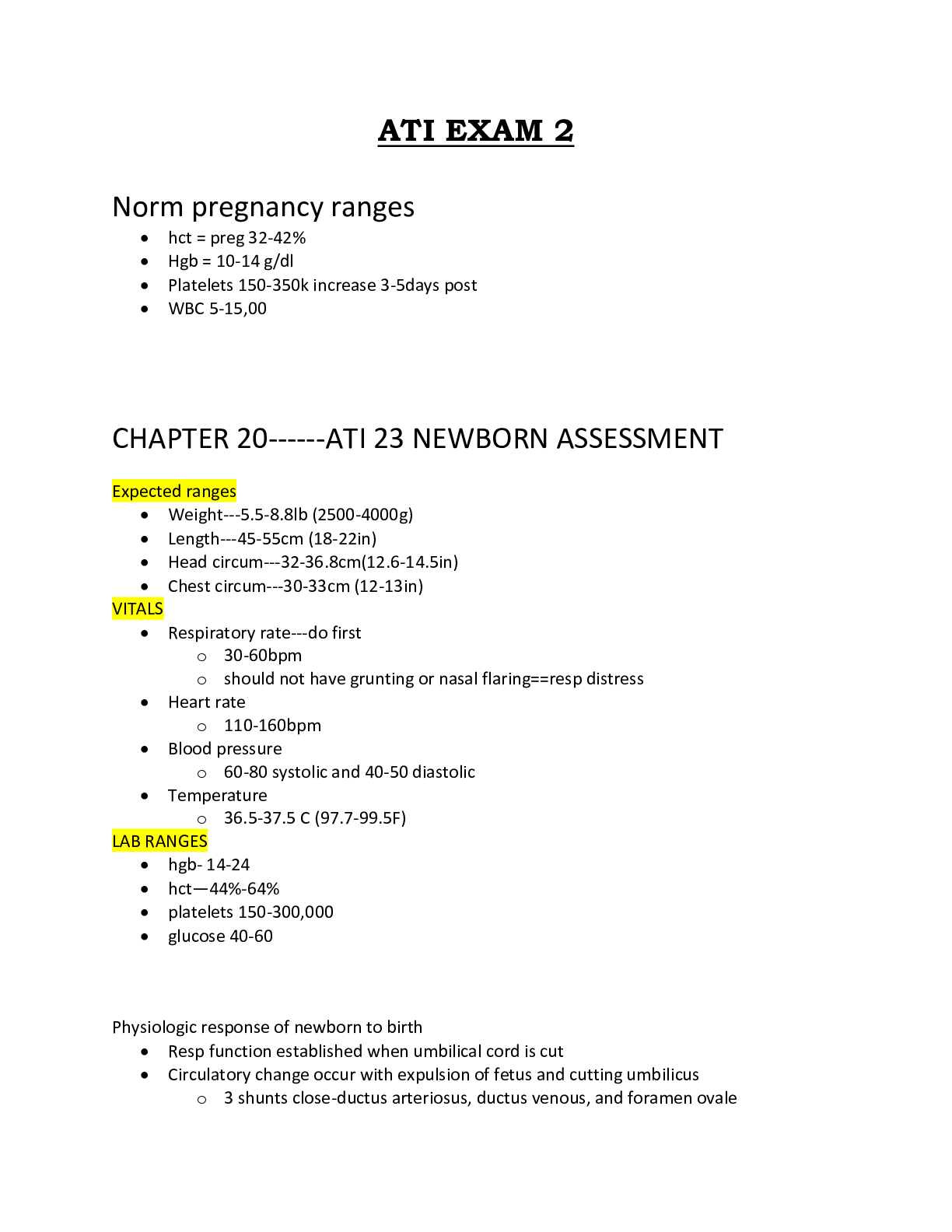
Buy this document to get the full access instantly
Instant Download Access after purchase
Add to cartInstant download
Reviews( 0 )
Document information
Connected school, study & course
About the document
Uploaded On
Jan 28, 2021
Number of pages
34
Written in
Additional information
This document has been written for:
Uploaded
Jan 28, 2021
Downloads
0
Views
84

